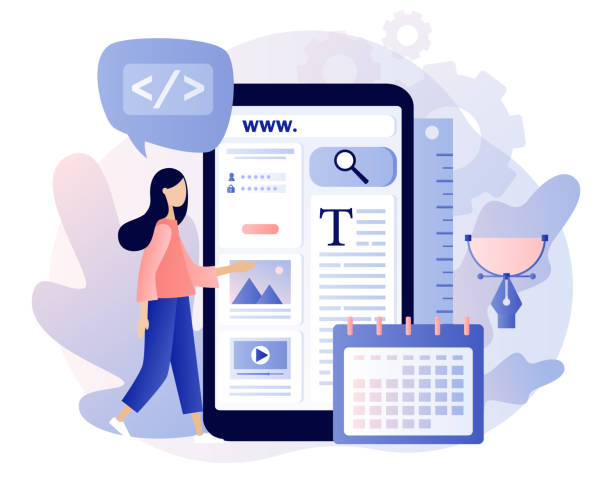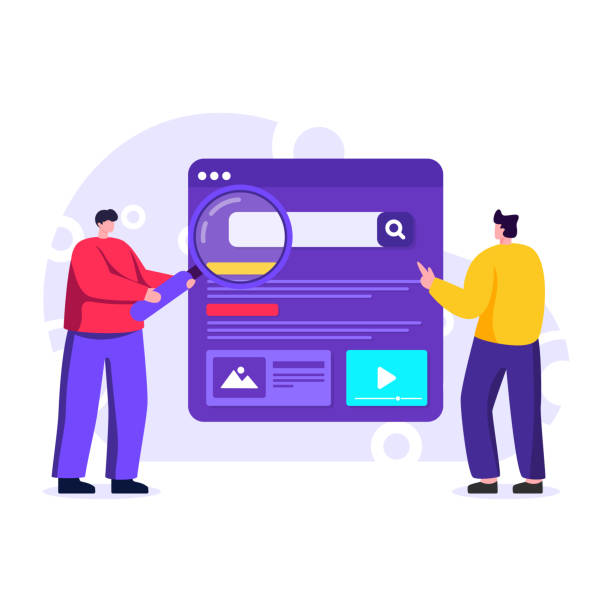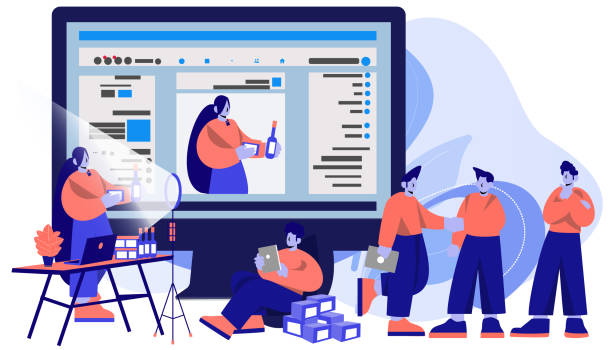Introduction to Responsive Web Design and Its Importance

In today’s digital world, where users access the internet from a variety of devices including smartphones, tablets, and desktops, having a fixed, inflexible website means losing a large segment of your audience.
This is where the concept of #ResponsiveWebDesign or Responsive Web Design becomes crucial.
#ResponsiveDesign is an approach to web design aimed at creating websites that can automatically adapt their layout and content to the screen size of the user’s device.
This means that regardless of the device a user employs, your website will always maintain a beautiful appearance and be easy to use.
The importance of this approach is not limited to visual aesthetics; it also leads to improved User Experience (UX) and Search Engine Optimization (SEO).
Years ago, Google announced that it prioritizes responsive websites, which has made responsive web design an industry standard.
Without a responsive website, your business may not only lose its mobile audience but also concede its search ranking to competitors.
This approach is not just a technical necessity, but a strategic investment for the future of your online presence.
Website adaptability across various devices is considered a major competitive advantage and directly impacts conversion rates and customer satisfaction.
Worried about losing customers because you don’t have a professional e-commerce site?
With e-commerce site design by Rasawweb, forget these worries!
✅ Significant increase in sales and visitor-to-customer conversion rate
✅ Professional and user-friendly design that builds customer trust
⚡ Get free consultation from Rasawweb
Core Principles of Responsive Design

For successful #ResponsiveWebDesign implementation, understanding three fundamental principles is essential: Fluid Grids, Flexible Images, and Media Queries.
These three pillars form the basis of every responsive website.
Fluid Grids use relative units like percentages instead of fixed pixels to define element widths.
This approach ensures that the website’s layout automatically adjusts to the screen size, and elements are positioned correctly.
For example, if a column has a width of 33.33%, it will always occupy one-third of its parent’s width, regardless of how large or small the parent is.
Flexible Images means that images must also be able to automatically resize.
This is usually achieved by setting the max-width: 100% property in CSS for images, which ensures that images do not exceed their parent’s width and do not get distorted on smaller devices.
Without flexible images, even if your layout is responsive, large images can break the design and disrupt the user experience.
Finally, Media Queries are CSS rules that allow you to apply different styles based on device characteristics such as screen width, height, orientation, or even device type (like a printer).
For example, you can define that on screens smaller than 600 pixels, the navigation bar is displayed vertically instead of horizontally.
This powerful tool allows web designers to provide the most optimized visual and functional experience for every screen size.
By combining these three principles, adaptive website design is implemented in the best possible way, and you will have a truly responsive website.
Popular Tools and Frameworks in Responsive Design

To accelerate the process of responsive web design and ensure its compatibility with various devices, web developers often use specific frameworks and tools.
These tools are collections of pre-written CSS and JavaScript files that allow you to quickly implement responsive layouts.
One of the most popular and widely used frameworks in this area is Bootstrap.
Bootstrap is a comprehensive framework that includes a fluid grid system, pre-built UI components (such as buttons, forms, navigation bars), and JavaScript plugins, all designed to be responsive.
This framework makes the work much easier for developers, especially beginners.
Another popular framework is Foundation, developed by Zurb and known for its high flexibility and focus on mobile-first development.
Foundation is a powerful tool for building complex and functional websites.
In addition, lighter frameworks like Bulma or Pure.css are available, suitable for smaller projects or when you need more control over CSS.
Using these frameworks not only accelerates the development process but also helps you correctly adhere to adaptive website design standards and prevent compatibility issues.
Choosing the right framework depends on the project’s needs and the development team’s familiarity level.
| Framework Name | Key Features | Advantages | Potential Disadvantages |
|---|---|---|---|
| Bootstrap | Strong grid system, many components, excellent documentation | High development speed, large community, suitable for beginners | Large file size, repetitive appearance (if not customized) |
| Foundation | Mobile-first, high flexibility, Sass tools | More control over appearance, suitable for complex projects | Slightly steeper learning curve, smaller community |
| Bulma | CSS-only, modular, Flexbox-based | Very lightweight, easy to learn, no JavaScript | Fewer components, requires separate JavaScript |
User Experience (UX) and Responsive Design

One of the most important reasons for implementing #ResponsiveWebDesign is improving User Experience (UX).
In fact, a responsive website is not just about adapting the layout, but about ensuring that your users have a consistent and enjoyable experience on any device.
This means paying attention to details such as Readability, Navigation, and Interaction.
On a responsive website, text should be adjusted to be readable on smaller screens – neither too small requiring zooming, nor too large occupying too much space.
Font size, line spacing, and paragraph widths should all be optimized.
Navigation also plays a crucial role.
On mobile devices, there is less space to display complex menus, so patterns like the Hamburger Menu or dropdown menus are common.
These types of menus should be easily accessible and provide important content to the user.
Furthermore, interactive elements such as buttons and forms should be large enough to be easily touched with a finger, and there should be sufficient space between them to prevent accidental errors.
Adaptive website design is not only visually appealing but also functionally empowers users to easily interact with your website, find the information they need, and perform desired actions.
Neglecting UX in responsive design can lead to high bounce rates and decreased customer satisfaction, even if your website is technically responsive.
This is an investment in earning user trust and loyalty.
Did you know that poor online store design can drive away up to 70% of your potential customers? Rasawweb transforms your sales with professional and user-friendly e-commerce website designs.
✅ Significant increase in sales and revenue
✅ Full optimization for search engines and mobile
⚡ [Get Free Consultation from Rasawweb]
SEO and Responsive Web Design

In the current era, SEO (Search Engine Optimization) and #ResponsiveWebDesign are two sides of the same coin.
Google, the world’s largest search engine, has prioritized mobile-optimized websites in its mobile search results since 2015.
With the introduction of the ‘Mobile-First Indexing’ algorithm in 2018, Google went even further, beginning to use the mobile version of websites for crawling, indexing, and overall site ranking.
This means that if your website is not properly optimized for mobile, you will not only fail to rank well in mobile searches but may even experience a drop in desktop search rankings.
A responsive website makes it much easier for Google’s crawlers by providing a single URL for all devices and using the same HTML and CSS code.
This prevents issues such as duplicate content that previously arose with separate mobile versions (e.g., m.example.com).
Additionally, Page Speed is an important factor in SEO, and responsive websites, if properly optimized, can offer a faster user experience.
Google consistently emphasizes the importance of user experience, and loading speed and mobile usability are key factors in this regard.
Therefore, responsive web design is not only essential for your users but also a critical requirement for visibility in search engines and attracting organic traffic.
Investing in responsive design is a direct investment in your website’s SEO.
Challenges and Solutions in Responsive Design

Although #ResponsiveWebDesign offers numerous benefits, its implementation is not without challenges.
One of the biggest concerns is Performance.
Responsive websites must optimize their images and content for various screen sizes.
If images are not properly optimized, loading times can be very long on mobile devices with slow internet, disrupting the user experience.
The solution to this problem is using Optimized Images, Lazy Loading, and next-generation image formats like WebP.
Another challenge is Legacy Browser Support.
While most modern browsers support CSS3 features like Media Queries, some older browsers may not have these capabilities.
The solution to this problem is using Polyfills or Fallbacks, which ensures your website remains accessible even in older browsers, although some advanced features may be lost.
Also, Testing and Debugging in different environments is a significant challenge.
Given the countless variety of devices and screen sizes, manually testing a website in all these scenarios is almost impossible.
Using Browser Emulators and automated testing tools can facilitate this process.
These tools help you ensure that your adaptive website design functions correctly on all devices.
Solving these challenges requires careful planning and the application of best practices in the development process.
Case Study of Successful Responsive Website Design

To better understand the effectiveness of #ResponsiveWebDesign, looking at successful examples can be very insightful.
These case studies show us how leading companies have used this approach to improve user experience and achieve their business goals.
One prominent example is the Airbnb website.
This accommodation platform is an excellent example of responsive design that provides a consistent user experience across all devices.
Whether you are on a desktop, tablet, or smartphone, the process of searching, viewing listings, and booking is smooth and seamless.
Large, high-quality images scale well, and navigation elements cleverly collapse for smaller screens.
Another example is the Smashing Magazine website, known as a pioneer in responsive web design.
This website demonstrates that even with a large volume of content and advertisements, a responsive and user-friendly design can be implemented.
They have adopted a mobile-first approach, meaning designing first for smaller screens and then scaling up to larger ones.
This approach ensures that the most important content is always accessible.
Also, websites like New York Times are good examples showing how news websites with abundant content can display well across various devices and maintain readability.
These examples demonstrate that with careful planning and correct implementation of responsive design principles, any type of website, from service platforms to news and educational sites, can achieve success and provide an unparalleled user experience.
| Website | Industry | Key Responsive Features | Why is it successful? |
|---|---|---|---|
| Airbnb | Tourism and Accommodation | Scalable images, adaptive navigation, optimized forms | Consistent user experience across all devices, easy booking process |
| Smashing Magazine | Media and Web Design | Mobile-first, managing large content, high readability | Pioneer in responsive design, maintaining content quality |
| New York Times | News | Adaptive columnar layout, optimized news images | Easy access to news on any device, preserving the news reading experience |
The Future of Web Design and the Role of Responsiveness

The future of #WebDesign is rapidly evolving, and #ResponsiveWebDesign must keep pace with these changes.
With the emergence of new technologies such as Progressive Web Apps (PWAs), Voice UI, and Augmented Reality, the boundaries of web design are expanding.
PWAs are websites that can be installed like native applications on a user’s device, offering capabilities such as offline work, push notifications, and faster access.
For a PWA to be successful, its responsive foundation is crucial, as it must perform consistently across different sizes and devices, including desktops, tablets, and mobiles.
Furthermore, with the growth of IoT devices and smart displays, the need for adaptive website design becomes increasingly apparent.
In the future, websites may be displayed not only on phones and tablets but also on smart refrigerators, digital mirrors, and even clothing.
This requires thinking beyond traditional screens and embracing a truly flexible approach to design.
#ResponsiveDesign will remain the backbone of these developments, but it will be complemented by new techniques and tools such as Container Queries (which allow elements to react based on their parent container’s size, not just the viewport).
These advancements enable designers to have more precise control over layouts in more complex scenarios.
The future of web design is bright, and responsiveness will form its core.
Does your current e-commerce site design not generate the expected sales for you?
Rasawweb is an expert in professional e-commerce website design!
✅ An attractive and user-friendly website aimed at increasing sales
✅ High speed and security for an ideal shopping experience⚡ Get free online store design consultation with Rasawweb!
Important Tips for Maintaining and Optimizing a Responsive Website

Building a #ResponsiveWebDesign is only half the battle; continuous maintenance and optimization are equally important to ensure your website always performs at its best and keeps pace with technological changes.
One critical aspect is Performance Monitoring.
Regularly check your website’s loading speed on various devices and different networks (such as 4G, 5G, or Wi-Fi).
Tools like Google PageSpeed Insights or Lighthouse can provide valuable insights into improving speed and optimizing images and CSS/JS codes.
Another point is regular testing on new devices.
The smart device market is rapidly changing, with new phones and tablets featuring different screen sizes and resolutions being introduced daily.
Ensure that your website is displayed correctly on these new devices as well.
You can use emulators or even physical devices for this purpose.
Also, updating libraries and frameworks (such as Bootstrap or React) that you have used to build your website is crucial.
These updates often include performance improvements, bug fixes, and support for new browser features.
Ignoring these updates can leave your website vulnerable to security flaws or compatibility issues.
Ultimately, adaptive website design is an ongoing process, and with regular attention and maintenance, your website can remain a powerful and efficient tool for years.
Conclusion and Next Steps in Responsive Web Design

In summary, #ResponsiveWebDesign is no longer a luxury option but a vital necessity for any business or individual seeking a successful presence in the digital world.
This approach not only significantly improves user experience but is also crucial for Search Engine Optimization (SEO), helping you gain visibility in search results.
From basic principles like fluid grids and flexible images to using advanced frameworks and paying attention to user experience details, every aspect of responsive design plays a key role in your website’s success.
For the next steps, if your website is not yet responsive, your main priority should be to convert it into a responsive website.
This can involve a complete redesign or a gradual optimization of existing elements.
For websites that are already responsive, the focus should be on performance optimization, continuous monitoring, and regular updates.
Always stay abreast of the latest web design trends and new technologies to ensure your website always operates at its peak efficiency.
Remember that today’s users have high expectations, and a fast, beautiful, and usable website on any device is the best way to meet these expectations and create a lasting experience for them.
Responsive web design is an investment in the future of your business.
Frequently Asked Questions
| Question | Answer |
|---|---|
| What is responsive web design? | Responsive Web Design is an approach where the design and layout of a website automatically adjust to the screen size and device of the user (such as desktop, tablet, mobile) to provide the best user experience. |
| Why is responsive web design important? | With the increasing use of mobile devices and tablets for browsing the internet, responsive design ensures that your website displays well on any screen size, and users do not need to zoom or scroll horizontally, which leads to an improved user experience and reduced bounce rate. |
| What are the main techniques used in responsive design? | The three main techniques include Flexible Grids, Flexible Images, and Media Queries in CSS. |
| What is a Media Query? | A Media Query is a CSS feature that allows you to apply different styles based on user device characteristics such as screen width, height, orientation (portrait or landscape), and resolution. |
| What impact does responsive design have on SEO? | Google prefers responsive websites and ranks them higher in mobile search results. Additionally, an improved user experience leads to a reduced bounce rate and increased time spent on the site, which are positive signals for search engines. |
And other advertising agency services by Rasawweb in the field of advertising
Smart UI/UX: A new service to increase click-through rates through key page optimization.
Smart Google Ads: A new service to increase click-through rates through intelligent data analysis.
Smart Google Ads: A professional solution for user engagement with a focus on optimizing key pages.
Smart Brand Identity: An effective tool for analyzing customer behavior with the help of intelligent data analysis.
Smart Marketing Automation: A creative platform for improving customer acquisition with custom programming.
And more than hundreds of other services in the field of online advertising, advertising consulting, and organizational solutions
Internet Advertising | Advertising Strategy | Advertorials
Resources
Responsive Web Design Guide
The Importance of Responsive Websites for Businesses
SEO and Responsive Design
Modern Web Design Trends
? For your business to leap forward in the digital world and experience unprecedented growth, Rasawweb Afarin is your smart partner. With our expertise in SEO, content marketing, and especially user-friendly website design, you will have a powerful and lasting online presence.
📍 Tehran, Mirdamad Street, next to Bank Markazi, Kazeroon Southern Alley, Ramin Alley No. 6

